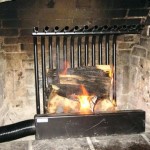Bio Ethanol Fireplaces: A Comprehensive Guide
Bio ethanol fireplaces represent a modern and increasingly popular alternative to traditional wood-burning fireplaces. These fireplaces offer a combination of aesthetic appeal, ease of use, and relatively clean combustion, making them a viable option for homes, apartments, and even outdoor spaces. This article provides a comprehensive overview of bio ethanol fireplaces, covering their functionality, advantages, disadvantages, safety considerations, and maintenance requirements.
The core principle behind a bio ethanol fireplace is its fuel. Bio ethanol, also known as ethyl alcohol, is a renewable fuel typically produced from fermented plant materials such as corn, sugarcane, or grains. When burned, bio ethanol produces primarily carbon dioxide, water vapor, and heat. Unlike wood-burning fireplaces, it doesn't produce smoke, soot, or ash, eliminating the need for a chimney or flue. This characteristic significantly simplifies installation and expands the range of locations where a fireplace can be installed.
Bio ethanol fireplaces are available in a wide variety of designs and sizes. They range from freestanding models that can be moved from room to room to wall-mounted units and even inserts that can be integrated into existing fireplace openings. The aesthetic variety allows for seamless integration into different interior design styles, from minimalist modern to rustic traditional.
Key Point 1: Understanding the Functionality of Bio Ethanol Fireplaces
The operation of a bio ethanol fireplace is relatively straightforward. The process begins with filling the burner chamber with bio ethanol fuel. The burner chamber is typically made of stainless steel and is designed to contain the fuel and regulate the rate of combustion. Once the chamber is filled to the recommended level, the fuel is ignited using a long lighter or a specifically designed ignition tool. Avoid using short lighters or matches, as the proximity to the flame can pose a burn risk.
The flame produced by a bio ethanol fireplace is a real flame, offering visual appeal similar to that of a wood-burning fireplace. The size and intensity of the flame can often be adjusted by controlling the opening of the burner chamber. Some models offer a sliding mechanism or a rotating lid that allows users to regulate the oxygen supply, thereby affecting the flame height and the rate of fuel consumption.
The heat output of a bio ethanol fireplace is typically measured in British Thermal Units (BTUs). The BTU rating indicates the amount of heat produced per hour. Bio ethanol fireplaces generally produce less heat than traditional wood-burning fireplaces, making them more suitable for supplemental heating or for creating ambiance in a room. The heat is radiated directly into the surrounding space, providing a localized warming effect. The duration of burn time depends on the size of the burner chamber and the intensity of the flame setting. A larger burner and a higher flame setting will result in a shorter burn time.
Refueling a bio ethanol fireplace requires caution. It is essential to allow the burner to cool down completely before adding more fuel. Adding fuel to a hot burner can cause a dangerous flare-up. It is also important to avoid overfilling the burner chamber, as this can lead to spills and potential fire hazards. Use a funnel to carefully pour the fuel into the chamber, and always wipe up any spills immediately with a damp cloth.
Key Point 2: Advantages and Disadvantages of Bio Ethanol Fireplaces
Bio ethanol fireplaces offer several advantages over traditional fireplaces. The absence of smoke, soot, and ash eliminates the need for a chimney or flue, which significantly reduces installation costs and allows for greater flexibility in placement. This is particularly beneficial for apartments or homes where a traditional fireplace is not feasible. Furthermore, bio ethanol fireplaces are often portable, allowing users to move them from room to room or even outdoors.
Another advantage is the relatively clean combustion of bio ethanol. When burned properly, bio ethanol produces primarily carbon dioxide and water vapor, with minimal emissions of harmful pollutants. This makes it a more environmentally friendly option compared to wood-burning fireplaces, which release particulate matter and other pollutants into the atmosphere.
Aesthetic appeal is also a significant advantage. Bio ethanol fireplaces are available in a wide range of styles and designs, from sleek and modern to rustic and traditional. This allows consumers to choose a fireplace that complements their existing decor. The visual appeal of a real flame adds ambiance and warmth to any space.
However, bio ethanol fireplaces also have some disadvantages. One of the primary drawbacks is the cost of bio ethanol fuel. Bio ethanol can be more expensive than wood or gas, depending on the region and the supplier. This can make it a less cost-effective option for homeowners who plan to use their fireplace frequently.
Another disadvantage is the heat output. While bio ethanol fireplaces provide a localized warming effect, they typically produce less heat than traditional wood-burning fireplaces. This may not be sufficient for heating a large room or for providing primary heat during cold weather. They are best suited for supplemental heating or for creating ambiance.
Finally, safety considerations are paramount. Bio ethanol is a flammable liquid, and improper handling can pose a fire risk. It is essential to follow all safety guidelines provided by the manufacturer, including allowing the burner to cool down completely before refueling and avoiding overfilling the burner chamber.
Key Point 3: Safety Considerations and Maintenance
Safety is of utmost importance when operating a bio ethanol fireplace. Bio ethanol is a flammable liquid and should be handled with care. Always store bio ethanol fuel in a cool, dry place away from heat sources and open flames. Keep the fuel out of reach of children and pets.
When refueling the fireplace, ensure that the burner has cooled down completely before adding more fuel. Adding fuel to a hot burner can cause a dangerous flare-up. Use a funnel to carefully pour the fuel into the chamber, and avoid overfilling. Wipe up any spills immediately with a damp cloth.
Ensure adequate ventilation in the room where the fireplace is being used. While bio ethanol combustion produces primarily carbon dioxide and water vapor, it is still important to have proper ventilation to prevent the build-up of carbon dioxide. Open a window or door periodically to allow fresh air to circulate.
Never leave a burning fireplace unattended. Keep children and pets away from the fireplace while it is in operation. Do not place flammable materials near the fireplace, such as curtains, furniture, or paper. Always have a fire extinguisher nearby in case of emergency.
Maintenance of a bio ethanol fireplace is relatively simple. Regularly clean the burner chamber to remove any residue or debris. Use a damp cloth to wipe down the exterior of the fireplace. Avoid using abrasive cleaners, as they can damage the finish. Check the burner chamber for any signs of wear or damage, and replace it if necessary. The longevity of the burner depends on the frequency of use and the quality of the fuel used.
The surface surrounding the fire should be heat resistant. Never place anything flammable on or near the fireplace when it is in use. Always ensure there is safe distance between the fire and other objects. Regularly inspect the area surrounding the fireplace to ensure there are no potential hazards.
By following these safety guidelines and maintenance tips, users can enjoy the benefits of a bio ethanol fireplace while minimizing the risk of accidents.
The choice of fuel is also relevant to safety and performance. Not all bio ethanol fuels are created equal. Opt for high-quality bio ethanol fuel that is specifically designed for use in fireplaces. Lower-quality fuels may contain impurities that can produce unpleasant odors or leave residue in the burner chamber.
Ultimately, bio ethanol fireplaces offer a compelling alternative to traditional fireplaces. Their ease of installation, clean combustion, and aesthetic appeal make them a desirable option for many homeowners. However, it is important to carefully consider the cost of fuel, safety precautions, and maintenance requirements before making a purchase.

Recommended Room Size For Bio Fire Buy Them Here

Order Gemini Bioethanol Fireplace From Hot Box Stoves 24 7 Delivery Service

Cocoon Pedestal Bioethanol Fireplace Wignells Heating Cooking

Henley Bioethanol Fireplace

Bioethanol Fires For Modern Living Firefly Complete Fireplace Solutions

Alden Bioethanol Fireplace

Is A Bioethanol Fireplace Part Of Your Dream Home

Bioethanol Installations Chesneys

Ethanol Fireplace Automatic Smart Remote Controlled Afire

What You Need To Know Bio Ethanol Fireplaces Visi








